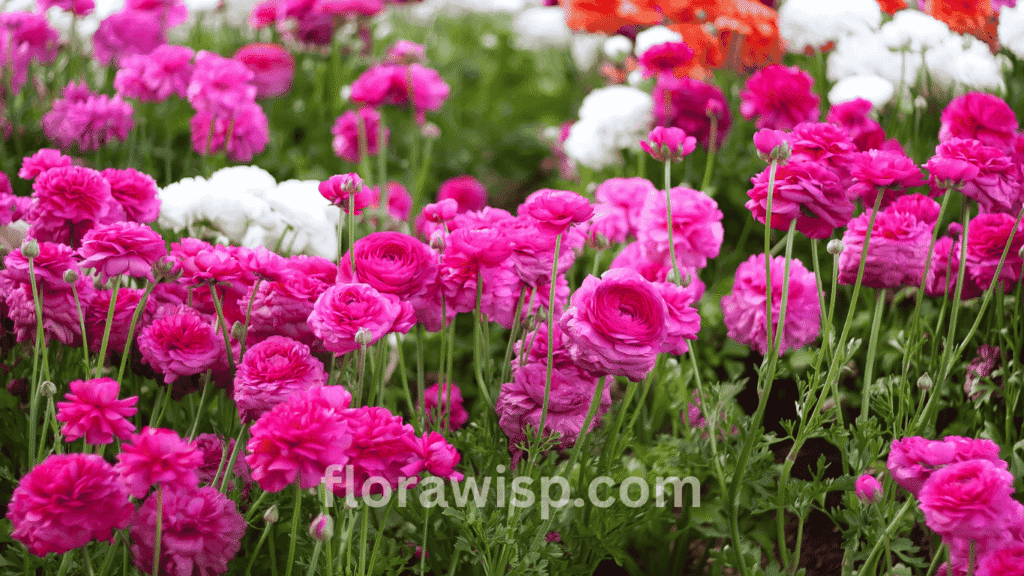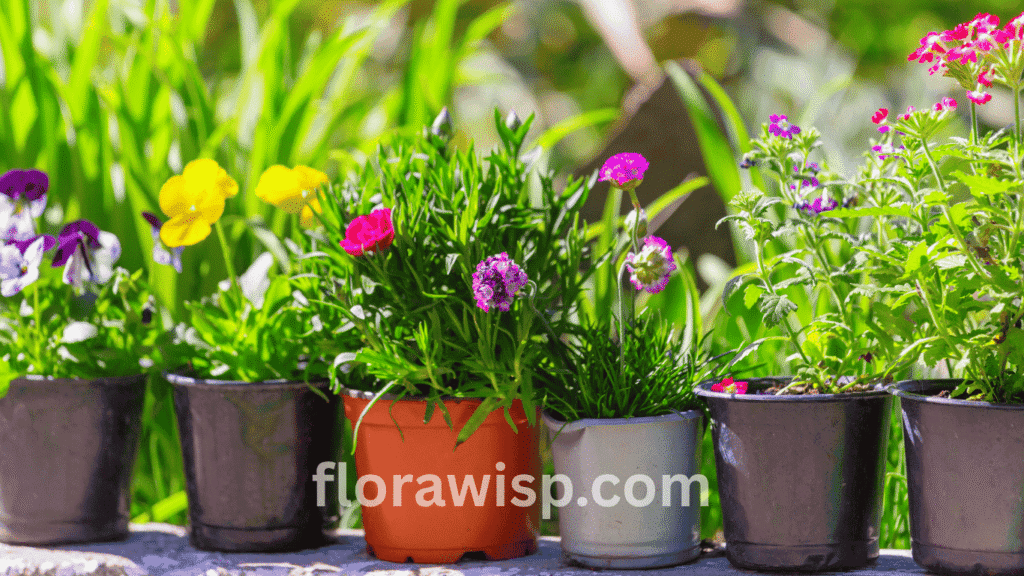Pink peonies captivate gardeners and flower lovers alike with their lush, layered petals, romantic fragrance, and breathtaking shades from blush pink to vibrant hot pink. Thriving in well-drained soil with full sun, these hardy perennials can bloom for decades, offering spectacular displays each late spring to early summer.
Light pink varieties like blush and pale peonies bring softness and elegance to wedding bouquets, while hot pink and deep tones create bold, eye-catching garden focal points. Proper planting depth, seasonal pruning, and balanced fertilization ensure strong roots and abundant blooms year after year. Whether paired with roses and hydrangeas in luxury arrangements or displayed solo in a crystal vase, pink peonies add timeless beauty indoors and out.
From selecting disease-free roots at local nurseries to sourcing rare cultivars online, knowing where and how to buy pink peonies ensures you get healthy plants that thrive. This guide explores varieties, care, and bouquet design ideas so you can enjoy their charm in every season fresh or as realistic artificial peonies. For more growing tips and inspiration, visit our comprehensive Peony Flower guide.
In This Article
Understanding Pink Peonies: Types and Varieties

Over the years of tending my gardens across different states, I’ve come to appreciate the incredible diversity of pink peonies. These blooms aren’t just flowers, they’re seasonal celebrations, each variety carrying its own character, shade, and charm.
From the whisper-soft blush tones to the bold, saturated hot pinks, knowing the subtle differences between varieties can make all the difference when selecting blooms for your garden, wedding bouquet, or home decor.
Peonies are classified not only by their bloom form but also by their color shade. Among pink varieties, you’ll encounter light pink, blush pink, pale pink, deep pink, dark pink, and hot pink tones each suited to different moods and uses. Some special varieties deserve a spotlight, such as the Pink Hawaiian Coral Peony with its tropical warmth, the elegantly structured Peony Pink Stanley, the layered Pompadour Peony, and the richly petal Staub Pink Peony.
Having grown them for years, I’ve found that pink peony varieties can differ in fragrance, bloom time, and even how they respond to certain climates. Choosing the right variety means balancing beauty with practicality, so your peonies thrive season after season. If you’re new to peonies, our complete guide on Growing Peonies will help you make the best choice for your garden.
Light Pink Peonies Varieties
Light pink peonies are the soft-spoken poets of the flower world, romantic, gentle, and endlessly versatile. Varieties like blush pink peonies and pale pink peonies are especially popular for spring weddings, baby showers, and vintage-style arrangements. Their blooms, often large and airy, look breathtaking in a light pink peonies bouquet, where they can blend seamlessly with white hydrangeas, cream roses, or lavender sprigs.
In my own garden, these softer shades tend to bloom just as early as their bolder counterparts but bring a calming, timeless elegance to the landscape. They also photograph beautifully, making them a favorite among event planners. The key to maximizing their impact is to pair them with pastel companions so their delicate color isn’t overshadowed.
Dark and Bright Pink Peonies Varieties

If light pinks are poetry, dark pink peonies are a passionate sonnet full of vibrancy and life. Gardeners who want a statement piece often gravitate toward bright pink peonies, deep pink peony types, and the show-stopping hot pink peonies. These blooms stand out vividly in flower beds and create high-contrast arrangements when paired with whites, yellows, or even the bold charm of a red peony.
In my experience, darker varieties tend to hold their color longer in the summer sun, making them ideal for areas with stronger light. When I design arrangements, I often tuck a few hot pink peonies into a pastel bouquet just to add a spark of drama. For gardeners aiming to draw attention, planting these near walkways or entry points ensures visitors get a striking first impression.
Specialty Pink Peonies
Some peonies stand apart for their unique look or history. The Pink Chinese Peony is an ancient favorite with lush petals and strong stems, perfect for cutting gardens. The Peony Pink Rose variety blends the form of a peony with the romance of a rose, while the pink peony with yellow center offers a joyful contrast of colors that catches the eye instantly.
For those who love peonies but want blooms that last beyond the season, artificial options are a wonderful alternative. A blush pink artificial peony can bring long-term beauty to table arrangements, while pink silk peonies offer a realistic texture and shade that work beautifully in permanent floral displays. In my own home, I keep a faux pink peony arrangement on my mantel. It still looks as vibrant as the day I arranged it, and guests often mistake it for fresh blooms.
Whether you choose fresh or faux, these specialty types add depth and variety to your collection, ensuring there’s always a new shade or form to enjoy.
Growing and Caring for Pink Peony Plants
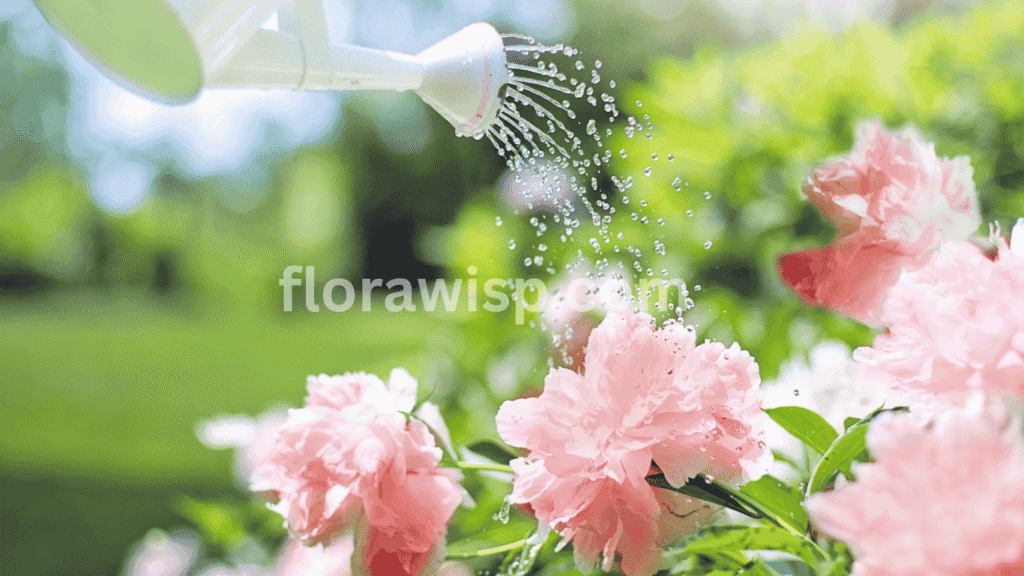
Pink peonies thrive best in well-drained, fertile soil with a neutral to slightly acidic pH, ideally between 6.5 and 7.0. They prefer full sun at least six hours of direct light each day to produce abundant blooms, though in regions with intense summer heat, a touch of afternoon shade can help protect delicate petals from scorching.
When planting, set the root crown no deeper than 2 inches below the soil surface. Planting too deep can delay flowering, something I learned the hard way in my early gardening years. Space plants 3–4 feet apart to ensure proper airflow, which reduces the risk of fungal problems.
Watering should be deep but infrequent, encouraging strong roots that withstand seasonal changes. I give my peonies about 1 inch of water per week during dry spells. Avoid overhead watering, as wet foliage can invite disease. A 2–3 inch layer of organic mulch helps retain moisture, suppress weeds, and regulate soil temperature year-round.
Pink Peony Bush & Shrub Care
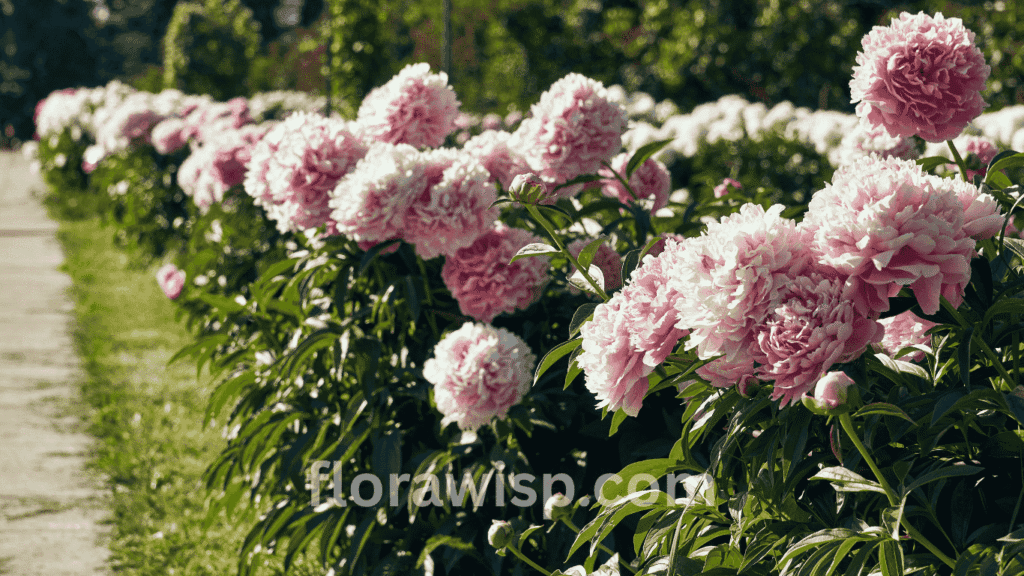
Healthy pink peony bushes and shrubs benefit from seasonal maintenance. Each fall, after the foliage dies back, I cut stems to ground level to prevent overwintering pests and diseases. In early spring, a balanced, slow-release fertilizer something like a 10-10-10 provides nutrients for lush foliage and strong blooms.
Deadheading spent flowers not only keeps plants tidy but also directs energy toward root development instead of seed production. Watch for common pests like aphids and thrips; a gentle spray of insecticidal soap can manage minor infestations. In damp, humid regions, peonies are prone to botrytis blight, so I recommend spacing them generously and avoiding excessive mulch around the crown. For gardeners interested in other varieties, the tree peony offers unique blooms and similar care tips.
Fragrance and Blooming Season
Few garden moments rival the first warm morning when your pink peony flowers open. Their fragrance is legendary, softly sweet with a hint of citrus or rose, depending on the variety. I often cut a few blooms for my kitchen table, and the scent can fill the room for days.
Pink peony plants generally bloom from late spring into early summer, with exact timing varying by USDA zone and variety. Early-season types may flower in mid-May, while late bloomers can continue into late June. The bloom window is brief, often just 7–10 days for each plant but when you stagger varieties, you can enjoy continuous pink peony blossoms for nearly a month.
The secret to a spectacular display year after year is consistent care: quality soil, proper sunlight, balanced feeding, and timely pruning. With these in place, your pink peony shrubs will reward you for decades with blooms that stop visitors in their tracks.
Pink Peonies Bouquets & Floral Arrangements
Over the years, I’ve found that pink peonies are more than just flowers; they are the heart of many unforgettable floral arrangements. Their large, layered blooms and soft, romantic shades make them a top choice for weddings, anniversaries, and any occasion where elegance is the goal. A pink peony bouquet instantly adds luxury and charm, whether it’s cradled by a bride or displayed in a crystal vase at a reception.
The beauty of pink peonies lies in their versatility. They work wonderfully on their own in a classic pink peony bouquet, but they also shine when paired with other blooms like pink roses, white peonies, and yellow peonies. These combinations create a layered, textured look that feels lush and timeless.
When arranging, I often play with contrasts pairing light pink peonies with deep rose tones, or surrounding vibrant hot pink peonies with airy white blossoms. The result is always eye-catching and perfect for both modern and vintage-inspired events.
Wedding Bouquets Featuring Pink Peonies
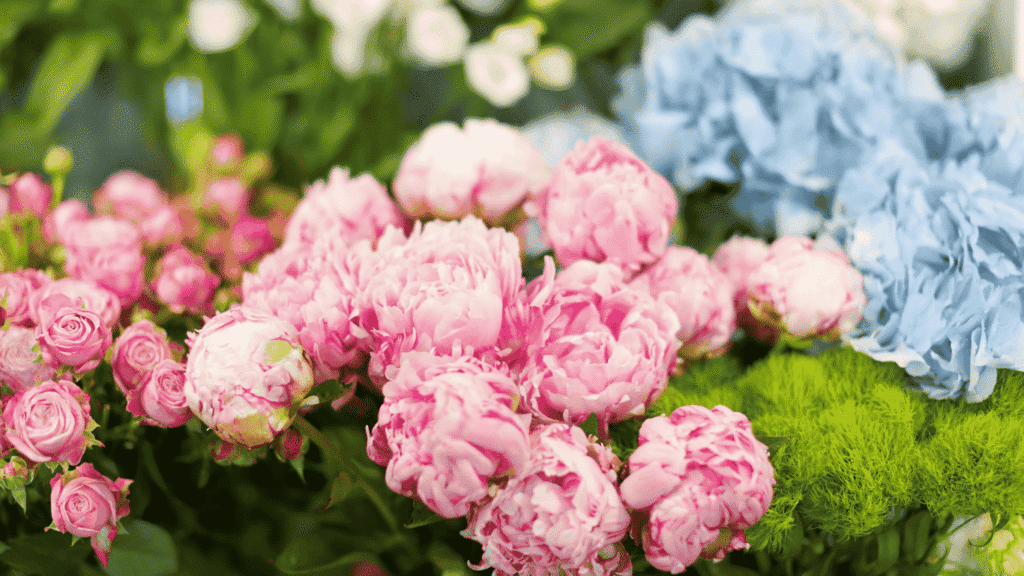
In my years as a gardener and floral designer, I’ve worked on countless wedding bouquets, and the pink peony wedding bouquet remains a favorite among brides. The bloom’s fullness and ruffled petals naturally evoke romance.
For a timeless look, tightly bound light pink peonies bouquet styles are ideal, especially for formal weddings. These create a polished, elegant feel that photographs beautifully.
For a softer, more whimsical style, I love using loose, garden-inspired arrangements. Here, pink peonies bouquet designs often mix shades of pale blush with slightly deeper pinks and weave in greenery for movement and texture. A bouquet of pink peonies can also be accented with ivory roses or delicate baby’s breath for a dreamy, ethereal touch.
One trend that continues to grow is blending pink and yellow peonies in summer weddings, offering a vibrant, joyful palette that feels fresh and modern while still romantic.
Bouquets with Mixed Flowers
While pink peonies are stunning solo, their beauty truly comes alive in mixed arrangements. Pairing pink roses and peonies creates a tone-on-tone look that is sophisticated yet warm. In spring, I often create pink peony and rose bouquets accented with lisianthus or ranunculus for added texture.
For striking contrast, combining pink and white peonies delivers a clean, elegant style perfect for minimalistic or black-tie weddings. In more playful settings, a mix of pink peonies with soft yellows and greens brings a cheerful, garden-fresh feel.
Even outside of weddings, pink peonies in a vase make a stunning home centerpiece. I recommend keeping stems long for a graceful drape, and pairing them with seasonal foliage to highlight their lush form. A pink peony flower bouquet in the dining room or entryway instantly brightens the space and welcomes guests with beauty and fragrance.
Buying Pink Peonies: Where and How
Whether you’re planting your very first peony bed or adding a special new variety, starting with strong, healthy roots will make all the difference in the number and quality of flowers you enjoy each season.
Local Nurseries: My First Recommendation
When people ask me “where can I buy pink peonies”, I always suggest starting at local nurseries. There’s no substitute for seeing the plants in person, checking their leaf color, stem strength, and root condition. Nurseries often carry varieties suited to your local climate, and you can speak directly to staff who know which cultivars thrive in your area. Over the years, I’ve picked up some of my healthiest pink peony plants from small, family-run garden centers.
Online Purchasing : A Convenient Option
If local options are limited or you’re looking for rare varieties, buying online can open up a world of possibilities. Reputable sellers offer pink peonies delivery directly to your doorstep, often packaged with care to prevent damage during transit. Always check reviews, ensure they guarantee live arrival, and order during the correct planting season for your zone. I’ve ordered bare-root pink peonies online with great success, but I make sure to plant them immediately upon arrival for the best start.
Understanding Pink Peonies Prices
The pink peonies price can vary greatly depending on the variety, size, and season. Specialty cultivars like the coral-pink or double-bloom types often cost more, while common varieties are more budget-friendly. Expect prices to rise in peak planting and blooming seasons due to higher demand. In my experience, investing a little more in a strong, disease-free plant pays off in healthier growth and more blooms year after year.
Popular Pink Peony-Related Products
Fresh blooms are always my favorite, but there are times when artificial options are ideal especially for indoor décor or events where live flowers might wilt too quickly.
Long-Lasting Beauty with Artificial Peonies

Decorative options like the blush pink artificial peony, faux pink peonies, and pink silk peony bring the romance of pink peonies indoors without the need for watering or sunlight.
I’ve used them in arrangements for summer weddings and in shaded reception halls where real flowers wouldn’t last. High-quality versions are so realistic that guests often try to smell them.
Designer & Lifestyle-Inspired Peony Decor
Beyond floral arrangements, pink peonies have inspired many home decor pieces. The Pottery Barn pink peony collection often features elegant, realistic blooms in decorative vases, while brands like pink peony Lululemon have incorporated floral-inspired prints into accessories and seasonal items. I’ve used these decor elements in my own home to keep the beauty of peonies alive year-round, even when the garden is resting for winter.
FAQs
Q. Where can I buy pink peonies?
You can buy pink peonies at local nurseries or trusted online plant stores offering delivery. I recommend checking seasonal availability and reviews to ensure plant quality. Many gardeners prefer buying in early spring for best planting results.
Q. How to care for pink peony plants?
Caring for pink peony plants involves planting them in well-drained soil with full sun, watering deeply but sparingly, and fertilizing in early spring. Pruning dead stems annually helps maintain healthy growth and abundant blooms.
Q. What are the best pink peony varieties for bouquets?
Light pink peonies like blush pink, pale pink, and Pompadour peonies are favorites for bouquets due to their soft colors and full blooms. Hot pink and deep pink varieties add vibrant accents when combined with other flowers.
Q. When do pink peonies bloom?
Pink peonies typically bloom in late spring to early summer, depending on your climate zone. Bloom duration lasts about 7-10 days, but deadheading can encourage extended flowering periods.
Conclusion
Pink peonies are more than just flowers; they’re living art that can bring romance, color, and elegance to any garden or bouquet. From the soft blush tones of light pink varieties to the bold drama of hot pink peonies, each type offers its own unique charm. With the right care, well-drained soil, plenty of sunlight, and seasonal maintenance, pink peony plants can reward you with decades of breathtaking blooms and unforgettable fragrance.
Whether you’re choosing pink peonies for your wedding bouquet, adding vibrant color to your landscape, or decorating your home with blush pink artificial peonies, there’s a perfect option for every gardener and style. Start by selecting healthy plants from trusted local nurseries or reputable online sellers, and invest in varieties that suit your climate for the best long-term results.
References
American Peony Society – Comprehensive Peony Growing Guide
American Peony Society – “Think Pink” Medium to Dark Pink Peony
Gardeners’ World – How to Grow Peonies
Gardener, M.Sc. Horticulture
Elara Bennet is a gardening writer from Austin, TX, passionate about sustainable lawns and blooms. Read full bio →

